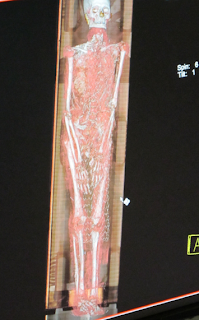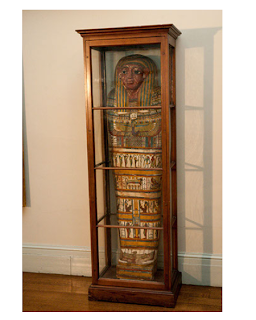Life of Padihershef:
Padihershef was a man who lived around 650 B.C. in Ancient Egypt. He was a stonecutter in Thebes and worked on rock cut tombs in the necropolis on the West Bank of Thebes. We know this because of the inscription on his case, Hrty-ntr, which means "stonecutter in the necropolis" in ancient Egyptian. His occupation as a stonecutter would mean that he spent much of his time underground surrounded by dust, poor circulation and stone. Unfortunately, there aren't any detailed descriptions on his coffin about cause of death. We are looking to the CT Scans to find further information on cause of death or diseases.
Padihershef's name translates to "one who is a gift of the god Hershef." The definition of Padihershef's name and his fathers, both incorporating the title Hershef , leads us to believe that Padi and his family was from Herakleopolis in Fayum, where the god Hershef was highly worshipped.
Knowing Padihershef's occupation, we know that he was a commoner and likely lived a modest lifestyle. His house would have been made of mud brick similar to architecture from the time period. According to Joyce Haynes catalogue,
Padihershef: The Egyptian Mummy,
"Padihershef's house would have been fairly small,
whitewashed inside and out, with a hard-packed mud floor.
Little existed in the way of furniture. A simple bed with a headrest was
considered a luxury. Small wooden chests would have been used to hold linens."
There would be straw mats on the floors and proper utensils in the kitchen for making bread and beer.
Like many other homes of the time, his house was possibly decorated with many religious icons and images on the walls. This of course included Bes, the guardian of the household.
 |
Figure of the god Bes
Courtesy of Joyce Haynes Catalogue "Padihershef: The Egyptian Mummy" |
Although Padihershef's coffin was very decorative and colorful, his tomb was not as elaborate. Majority of the funerary finances were spent on the mummification process which means Padihershef likely had a shared tomb.
All these small details and inscriptions from Padi's coffin gives us an inside glimpse of how Padihershef may have lived.
***Much of this entry was information taken from Joyce Haynes essay "Padihershef: The Egyptian Mummy." Joyce Haynes, who translated Padihershef's coffin in 1984, did an amazing job of transcribing the heiroglyphs and iconography on his coffin. This process helped to decipher many aspects of his life which facilitated The Padihershef Conservation Project. Thank you Joyce for your research and dedication to the Padihershef project.
Picture courtesy of Joyce Haynes' catalogue Padihershef; The Egyptian Mummy


























